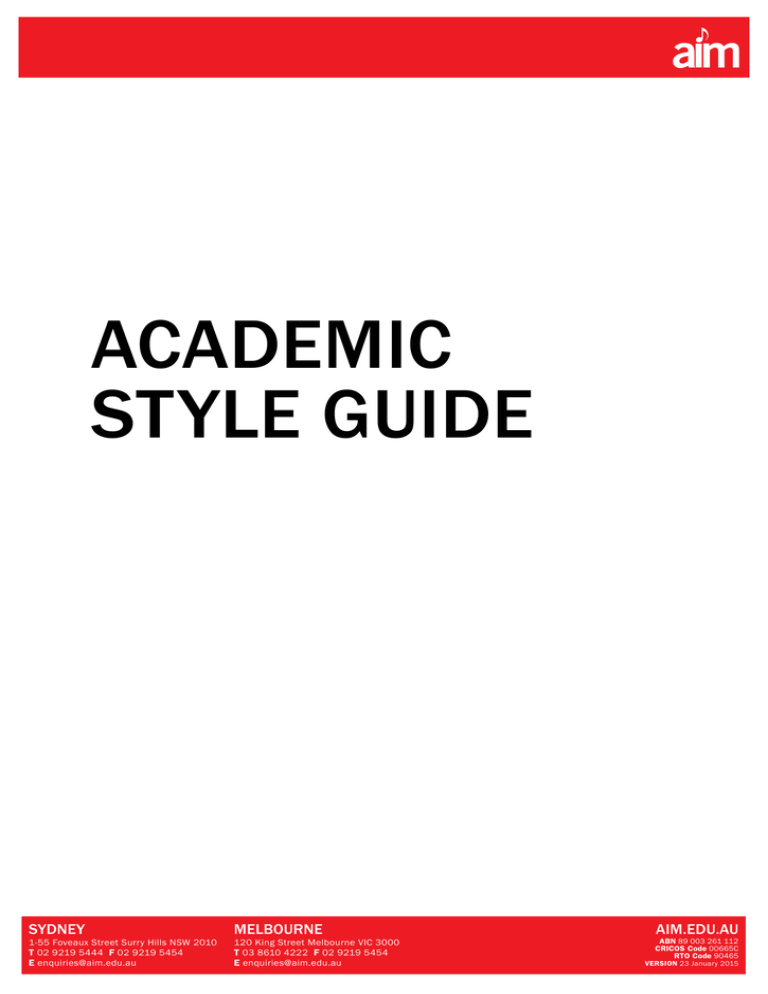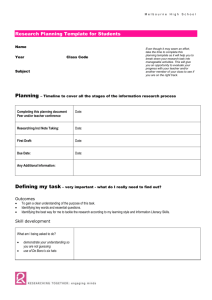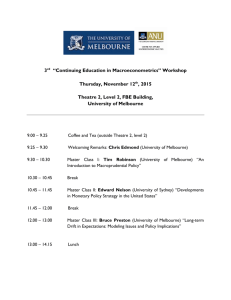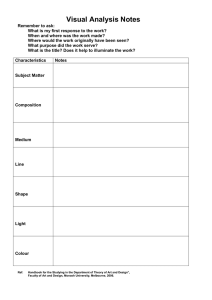
ACADEMIC
STYLE GUIDE
SYDNEY
1-55 Foveaux Street Surry Hills NSW 2010
T 02 9219 5444 F 02 9219 5454
E enquiries@aim.edu.au
MELBOURNE
120 King Street Melbourne VIC 3000
T 03 8610 4222 F 02 9219 5454
E enquiries@aim.edu.au
AIM.EDU.AU
ABN 89 003 261 112
CRICOS Code 00665C
RTO Code 90465
VERSION 23 January 2015
2015 © Australian Institute of Music
All Rights Reserved. 4th Edition 2015.
Sydney 1-55 Foveaux Street Surry Hills NSW 2000 Australia
Melbourne 120 King Street Melbourne VIC 3000 Australia
Prepared by Dr Clive Graham
Layout design by Michelle Weston
DISCLAIMER
This guide contains information that is current at the date of publication. AIM takes all due care to ensure
that the information contained is accurate, but reserves the right to vary any information described in
this publication without notice. Questions regarding the information in this guide can be emailed to
enquiries@aim.edu.au or by contacting AIM Student Services on: +61 2 9219 5444.
SYDNEY
1-55 Foveaux Street Surry Hills NSW 2010
T 02 9219 5444 F 02 9219 5454
E enquiries@aim.edu.au
MELBOURNE
120 King Street Melbourne VIC 3000
T 03 8610 4222 F 02 9219 5454
E enquiries@aim.edu.au
i
AIM.EDU.AU
ABN 89 003 261 112
CRICOS Code 00665C
RTO Code 90465
VERSION 23 January 2015
CONTENTS
1 USING THE AIM ACADEMIC STYLE GUIDE1
2 GUIDELINES FOR SUBMISSION2
3 THE AIM STYLE4
3.1 QUOTATIONS
3.1.1 QUOTING FROM A BOOK OR ARTICLE
3.1.2 QUOTING FROM A FILM
3.2 TABLES, FIGURES AND DIAGRAMS
3.3 FOOTNOTES
3.4 CITATION
3.4.1 MANNERS OF CITATION
3.4.2 WEB DOCUMENTS
3.4.3 SPECIAL RULES
4
4
5
5
5
6
6
7
7
4 BIBLIOGRAPHY8
4.1 HOW TO REFERENCE A BOOK
4.2 HOW TO REFERENCE A JOURNAL ARTICLE
4.3 HOW TO REFERENCE A WEBSITE
4.4 HOW TO REFERENCE A FILM
4.5 HOW TO REFERENCE MUSIC
4.6 HOW TO REFERENCE A PATENT
8
8
9
9
9
9
5 APPENDICES10
5.1 APPENDIX 1: EXAMPLES OF IN-TEXT AND BIBLIOGRAPHY CITATIONS
5.2 APPENDIX 2: MUSICAL EXAMPLES AND ABBREVIATIONS
10
13
iii
SYDNEY
1-55 Foveaux Street Surry Hills NSW 2010
T 02 9219 5444 F 02 9219 5454
E enquiries@aim.edu.au
MELBOURNE
120 King Street Melbourne VIC 3000
T 03 8610 4222 F 02 9219 5454
E enquiries@aim.edu.au
AIM.EDU.AU
ABN 89 003 261 112
CRICOS Code 00665C
RTO Code 90465
VERSION 23 January 2015
1 USING THE AIM ACADEMIC STYLE GUIDE
1 USING THE AIM ACADEMIC STYLE GUIDE
The AIM Academic Style Guide is a “guide” to assist students to reference academic texts
used in assignments.
In Higher Education, a consistent reference style is important so that others can access
the sources cited which is the purpose of the AIM Academic Style Guide
There are three major academic style guides: the APA (American Psychological
Association) style which is the most formal with a lot of punctuation formalities to be
observed, the Chicago style which employs footnote referencing (which is not permitted
by many academic institutions including AIM), and the Harvard style which the most
commonly employed in academic writing and which has evolved to eliminate most of the
periods, commas and brackets of former academic styles. The AIM Academic Style Guide
is based on the Harvard style.
The most important feature of academic style is consistency. Whatever style you
employ in association with your lecturer, you must stick with the one style throughout the
assignment. Do not change styles in an assignment.
It is not possible to cover every contingency concerning sources to be referenced.
However, the general style principles for the most frequently employed citations are
contained in the AIM Academic Style Guide and you should be able to work out a valid
reference for anything omitted. If not, ask your lecturer.
We have selected a minimalist style for the AIM Academic Style Guide and urge you to
use it in all assignments. It is a style increasingly employed by numbers of universities
worldwide.
1 of 15
SYDNEY
1-55 Foveaux Street Surry Hills NSW 2010
T 02 9219 5444 F 02 9219 5454
E enquiries@aim.edu.au
MELBOURNE
120 King Street Melbourne VIC 3000
T 03 8610 4222 F 02 9219 5454
E enquiries@aim.edu.au
AIM.EDU.AU
ABN 89 003 261 112
CRICOS Code 00665C
RTO Code 90465
VERSION 23 January 2015
2 GUIDELINES FOR SUBMISSION
2 GUIDELINES FOR SUBMISSION
PAPER
A4 white, single sided printing only.
ORIENTATION
Portrait, unless the graphic template calls for landscape.
MARGINS
A4 Standard margin set-up.
FONT
Arial. 12point. Handwritten assignments are not acceptable.
REFERENCING
The AIM Style (see section 3) is preferred.
LINE SPACING
Double spacing throughout.
PARAGRAPH SPACING
Double line space between paragraphs.
COVER PAGE
All Assignments must have a cover page containing:
Your name
Your student number
Your unit name
Your Lecturer’s name
The Title and number of assignment. Check your EUO (Extended Unit Outline) for this
information.
Due Date
This is in addition to the official AIM cover sheet.
2 of 15
SYDNEY
1-55 Foveaux Street Surry Hills NSW 2010
T 02 9219 5444 F 02 9219 5454
E enquiries@aim.edu.au
MELBOURNE
120 King Street Melbourne VIC 3000
T 03 8610 4222 F 02 9219 5454
E enquiries@aim.edu.au
AIM.EDU.AU
ABN 89 003 261 112
CRICOS Code 00665C
RTO Code 90465
VERSION 23 January 2015
2 GUIDELINES FOR SUBMISSION
IDENTIFICATION
At the top right hand corner of all pages, the assignment must include:
Your name
Your student number
The page number in the format Page X of Y
BIBLIOGRAPHY
At the end of the assignment you must include a Bibliography which includes ONLY the
references for citations referred to in-text.
MUSICAL EXAMPLES
Unless otherwise specified in the EUO, all musical examples should be typeset using
a musical notation program (eg Musescore, Finale or Sibelius). If you are permitted
to use a published score you must cite this correctly (including publisher and date of
publication). If you are using a catalogued work, you must use the catalogue number
correctly, eg. K.317, BWV232 or H1/101. If using Opus numbers, use Op.19/2 for
Chopin’s Nocturne Opus 19, number 2.
Musescore is available free of charge from http://www.musescore.org
ACCOMPANYING CDS AND USBS
Accompanying CDs must comply with the following standards:
CDs must be clearly labeled with the student’s name, the student’s number, the
assignment number and name, the unit number and name and the lecturer’s name
CDs and USBs must be presented in a clear plastic sleeve. Do not attach jewel cases
directly to paper with sticky-tape.
All audio tracks presented as part of AIM assessments must be obtained legally.
DICTIONARY
The dictionary used at AIM is the fifth edition of the Macquarie Dictionary, a copy of which
is held in the library. All spelling should be as in the Macquarie Dictionary.
3 of 15
SYDNEY
1-55 Foveaux Street Surry Hills NSW 2010
T 02 9219 5444 F 02 9219 5454
E enquiries@aim.edu.au
MELBOURNE
120 King Street Melbourne VIC 3000
T 03 8610 4222 F 02 9219 5454
E enquiries@aim.edu.au
AIM.EDU.AU
ABN 89 003 261 112
CRICOS Code 00665C
RTO Code 90465
VERSION 23 January 2015
3 THE AIM STYLE
3THE AIM STYLE
There are two essential parts of the AIM Style:
The Citation which is contained in the text which provides information about the source
of evidence employed; and.
The Bibliography which is placed at the end of the assignment under the heading
Bibliography. This lists detailed information about what references have been used
to write the assignment. Only references employed in the body of the assignment are
listed in the Bibliography.
3.1 QUOTATIONS
3.1.1 QUOTING FROM A BOOK OR ARTICLE
If you are quoting the text from a normal source (book, article etc), there are two rules. If
the quotation is under three lines in length, quote in-text with quotation marks
As a solo artist, Diana Ross is one of the most successful female singers of the
rock era. As Ruhlmann notes, “If you factor in her work as the lead singer of the
Supremes in the 1960s, she may be the most successful” (Ruhlmann 2009: 32)
Motown initially paired her with writer/producers Nicholas Ashford and Valarie
Simpson.
If the quotation is over three lines in length, indent from the rest of your text, italicize and
place in single spacing
As a solo artist, Diana Ross is one of the most successful female singers of the rock
era. As Ruhlmann says:
If you factor in her work as the lead singer of the Supremes in the 1960s,
she may be the most successful. With her friends Mary Wilson, Florence
Ballard, and Barbar Martin, Ross formed the Primettes vocal quartet in 1959.
In 1960, they were signed to local Motown Records, changing their name
to the Supremes (renamed Diana Ross and the Supremes” in 1967 when
Cindy Birdsong replaced Ballard) and scored twelve number one pop hits.
(Ruhlmann 2009: 32)
Motown initially paired her with writers/producers Nicholas Ashford and Valarie
Simpson…
4 of 15
SYDNEY
1-55 Foveaux Street Surry Hills NSW 2010
T 02 9219 5444 F 02 9219 5454
E enquiries@aim.edu.au
MELBOURNE
120 King Street Melbourne VIC 3000
T 03 8610 4222 F 02 9219 5454
E enquiries@aim.edu.au
AIM.EDU.AU
ABN 89 003 261 112
CRICOS Code 00665C
RTO Code 90465
VERSION 23 January 2015
3 THE AIM STYLE
3.1.2 QUOTING FROM A SCRIPT
For a short film quote by a single character, use quotation marks.
In Lantana, a series of marital crises provoke the film’s turning points.
“I’m still in love with my wife, Jane” Leon confesses, leaving Jane devastated.
(Lantana Scene 46.)
If you are quoting a longer passage of dialogue, set it out as it would appear in a film
script, with the characters’ names ABOVE their lines:
LEON
I’m still in love with my wife, Jane.
Jane withdraws her hand.
I’m sorry.
JANE
Then…why have you been seeing me?
LEON
I don’t know. It’s not something I planned.
(Lantana Scene 46.)
3.2 TABLES, FIGURES AND DIAGRAMS
Tables, figures and diagrams, including a musical notation, should be labeled as follows:
Figure 3/ Diagram 4/ Table 1
Leonard Bernstein (Epstein 2013, p.24)
Tables, figures and diagrams are numbered sequentially but with separate numbering for
each type.
3.3 FOOTNOTES
While footnotes are not used for citation in the AIM Style, they may be used to provide
additional information about the subject matter of the assignment. Footnotes should be
numbered sequentially.
5 of 15
SYDNEY
1-55 Foveaux Street Surry Hills NSW 2010
T 02 9219 5444 F 02 9219 5454
E enquiries@aim.edu.au
MELBOURNE
120 King Street Melbourne VIC 3000
T 03 8610 4222 F 02 9219 5454
E enquiries@aim.edu.au
AIM.EDU.AU
ABN 89 003 261 112
CRICOS Code 00665C
RTO Code 90465
VERSION 23 January 2015
3 THE AIM STYLE
3.4 CITATION
The AIM Style requires that you include a citation at the point where you cite the
information. Include the author’s name, year of publication and page number in brackets.
Note that the full stop goes after the citation.
The Yardbirds gained a large following in London after they took over the Rolling
Stones residency at Richmond’s Crawdaddy Club (Garofalo 2008: 55).
3.4.1 MANNERS OF CITATION
CITING WORKS WHICH EMPLOY GENERAL INFORMATION
Garofalo (2008) talks of the early days of the Yardbirds in her book Rocking Out.
PARAPHRASING
As Garofalo (2008) asserts, the Yardbirds gained a large following in London after
they took over the Rolling Stones’ residency at Richmond’s Crawdaddy Club.
The Yardbirds gained a large following in London after they took over the Rolling
Stones’ residency at Richmond’s Crawdaddy Club (Garofalo 2008).
DIRECT QUOTATION
Garofalo says “the Yardbirds gained a large following in London after they took over
the Roling Stones’ residency at Richmond’s Crawdaddy Club” (2008: 55).
The Yardbirds “gained a large following in London after they took over the Rolling
Stones’ residency at Richmond’s Crawdaddy Club” (Garofalo 2008: 55).
A QUOTATION IN A SOURCE
It was at this time Clapton fell in love with the guitar. He said “the sound of an
amplified guitar in a room full of people was so hypnotic and addictive to me, that I
could cross any kind of border to get on there.” (Clapton qtd Garofalo 2008: 55).
USING A WORD UNIQUE TO THE SOURCE
A detailed discussion of indeterminancy has been provided by influential 20th
Century composer John Cage (Cage 1961).
6 of 15
SYDNEY
1-55 Foveaux Street Surry Hills NSW 2010
T 02 9219 5444 F 02 9219 5454
E enquiries@aim.edu.au
MELBOURNE
120 King Street Melbourne VIC 3000
T 03 8610 4222 F 02 9219 5454
E enquiries@aim.edu.au
AIM.EDU.AU
ABN 89 003 261 112
CRICOS Code 00665C
RTO Code 90465
VERSION 23 January 2015
3 THE AIM STYLE
PRESENTING FACTUAL INFORMATION FOUND IN A SOURCE
The word “hip” was also used as a synonym for “beat” in the mid-1950s (Summer
1957).
USING IMAGES, MAPS, DIAGRAMS, TABLES,
OR CREATIVE WORKS THAT ARE NOT YOUR OWN
Figure 1.20: Double sharps raise the pitch by two half steps. Double flats lower the
pitch by two half steps (Schmidt-Jones 2007, p.18).
3.4.2 WEB DOCUMENTS
When citing a website which has no single author or page number can be approached in
a few ways.
Look for the copyright information that can sometimes be found at the bottom of the page
Look in the page source for the website (accessed in your browser by View/Page Source)
Cite the organisation which put the website together
When there are no page numbers on the website, use the following: (Musica 2014, URL)
Dates can be hard to find on some web documents. Check the page source and look for
copyright information. If you are sure that there is no date, write “(n.d.)” in place of the
date.
3.4.3 SPECIAL RULES
The following citation concepts refer to specific genres, as an example:
For a play, cite by scene number (e.g., Scene 17).
For a classic text (eg. Shakespeare) cite according to the following format:
Act V: Scene V: ll 16 -23.
For a movie, cite by timecode (e.g., 00:43:21).
For a modern piece of music, cite by songwriter, work and bars e.g.; Joel, B., Uptown
Girl, bb.15-19.
For a classical work, cite by composer, work (Movement), catalogue number and bars
e.g., Mozart, W.A., Coronation Mass, II Gloria, K317, bb.49-55.
If a classical work uses opus numbers rather than a catalogue number, cite as follows
e.g., Chopin, F. Nocturne, Op 9/2, bb.21-25.
7 of 15
SYDNEY
1-55 Foveaux Street Surry Hills NSW 2010
T 02 9219 5444 F 02 9219 5454
E enquiries@aim.edu.au
MELBOURNE
120 King Street Melbourne VIC 3000
T 03 8610 4222 F 02 9219 5454
E enquiries@aim.edu.au
AIM.EDU.AU
ABN 89 003 261 112
CRICOS Code 00665C
RTO Code 90465
VERSION 23 January 2015
4 BIBLIOGRAPHY
4BIBLIOGRAPHY
The Bibliography is placed at the conclusion of the written assignment prior to any
appendices. It contains sources employed in the assignment listed in alphabetical order
with one line spacing between each source.
AIM RULE: The Bibliography contains only sources referred to in the text or body of the
assignment. DO NOT LIST REFERENCES WHICH ARE NOT CITED IN THE ASSIGNMENT.
4.1 HOW TO REFERENCE A BOOK
Author of the book
↓ Year of publication
↓
↓
Title of the book
↓
Reising R 2005. Speak to Me: The Legacy of Pink Floyd’s The Dark Side of the
Moon. Hampshire: Ashgate Publishing
↑
↑
↑
Publisher of the book
Where the publisher is located
4.2 HOW TO REFERENCE A JOURNAL ARTICLE
Author of the article
↓ Year of publication
↓
↓
Title of the article
↓
Haus G 2004. ‘A Score Driven Approach to Music Information Retrieval’ in Journal
of the American Society for Information Society and Technology 55(12) pp. 12-16
↑
↑
↑
Title of the Journal
Volume and number Page in
of the journal
which the
article is
located
8 of 15
SYDNEY
1-55 Foveaux Street Surry Hills NSW 2010
T 02 9219 5444 F 02 9219 5454
E enquiries@aim.edu.au
MELBOURNE
120 King Street Melbourne VIC 3000
T 03 8610 4222 F 02 9219 5454
E enquiries@aim.edu.au
AIM.EDU.AU
ABN 89 003 261 112
CRICOS Code 00665C
RTO Code 90465
VERSION 23 January 2015
4 BIBLIOGRAPHY
4.3 HOW TO REFERENCE A WEBSITE
Author of the article
The name of the website
↓ Year of Publication (If known)
↓
The URL of the website
↓
↓
↓
↓
Ruhlmann W 2009. Diana Ross. Allmusic http://www.allmusic.com accessed
December 2013
↑
↑
Date of access
Title of the article
4.4 HOW TO REFERENCE A FILM
Director
↓
Year of release
↓
↓
Distributor
↓
Lawrence R 2001. Lantana. Palace Films
↑
Film Title
4.5 HOW TO REFERENCE MUSIC
Author/Composer
↓ Year of publication
↓
↓
Place of Publication
↓
Bartok B 2006. Violin Concerto No 2, London: Boosey & Hawkes
↑
↑
Title e
Publisher
4.6 HOW TO REFERENCE A PATENT
Author of the Article
↓
Year of publication
↓
↓
Title
↓
Beauchamp GD 1997. Electrical Stringed Musical Instrument, US Patent 2089171
↑
Patent Number
9 of 15
SYDNEY
1-55 Foveaux Street Surry Hills NSW 2010
T 02 9219 5444 F 02 9219 5454
E enquiries@aim.edu.au
MELBOURNE
120 King Street Melbourne VIC 3000
T 03 8610 4222 F 02 9219 5454
E enquiries@aim.edu.au
AIM.EDU.AU
ABN 89 003 261 112
CRICOS Code 00665C
RTO Code 90465
VERSION 23 January 2015
5APPENDICES
The Bibliography is placed at the conclusion of the written assignment prior to any
appendices. It contains sources employed in the assignment listed in alphabetical order
with one line spacing between each source.
AIM RULE: The Bibliography contains only sources referred to in the text or body of the
assignment. DO NOT LIST REFERENCES WHICH ARE NOT CITED IN THE ASSIGNMENT.
5.1 APPENDIX 1
EXAMPLES OF IN-TEXT AND BIBLIOGRAPHY CITATIONS
SOURCE
IN-TEXT
REFERENCE
BIBLIOGRAPHY
BOOKS
AUTHOR
UNKNOWN
(Anonymous 2013:
49-81)
ORGANIZATIONAL
AUTHORS
(Museum Ludwig
Cologne 1996)
ONE AUTHOR
(Reising 2005: 3)
TWO AUTHORS
(Pine & Gilmore
2011)
THREE AND MORE (Burkholder et al
AUTHORS
2009: 98)
AN EDITED BOOK
(Reisling 2002)
A SECTION OF A
BOOK
(Mendelsohn 2009:
358-368)
A SECTION OF AN
EDITED BOOK
(Covach 2005: 6576)
Anon 2013. Don’t Drop a Condenser Mic
and Other Suggestions. Sydney: Punk Press
pp. 49-81
Museum Ludwig Cologne 1996. 20th
Century Photography. Cologne: Taschen
Reising R 2005. Speak to Me: The Legacy
of Pink Floyd’s The Dark Side of the Moon.
Hampshire: Ashgate Pub
Pine B J & Gilmore J H 2011. The
Experience Economy. Boston: Harvard
Business Review Press
Burkholder J P, Grout D J & Palisca C V
2009. A History of Western Music. New
York: Norton
Reisling W (ed) 2002. Scream At Me: The
Legacy of Funk Boyd’s The Deep Light in the
Lagoon. Dampshire UK: Lashgate Publishing
Mendelsohn D 2009. ‘Double Take’ in How
Beautiful It Is and How Easily It Can Be
Broken: Essays. Sydney: Harper Collins, pp.
358-368
Covach J 2005. ‘Form in Rock Music: A
Primer.’ in Stein D J (ed) Engaging Music:
Essays in Music Analysis. New York: Oxford
University Press pp. 65-76
10 of 15
SYDNEY
1-55 Foveaux Street Surry Hills NSW 2010
T 02 9219 5444 F 02 9219 5454
E enquiries@aim.edu.au
MELBOURNE
120 King Street Melbourne VIC 3000
T 03 8610 4222 F 02 9219 5454
E enquiries@aim.edu.au
AIM.EDU.AU
ABN 89 003 261 112
CRICOS Code 00665C
RTO Code 90465
VERSION 23 January 2015
IN-TEXT
REFERENCE
SOURCE
BIBLIOGRAPHY
JOURNAL ARTICLES
AUTHOR
UNKNOWN
ORGANIZATIONAL
AUTHORS
ONE AUTHOR
Anon 1880. ‘The Progression of Jazz is
Still Miles Away’ Journal of Very Old Music
Writings 121(1) pp. 1-9
Society for 8-Bit Music 1999. ‘They Haven’t
(Society for 8-Bit
Quite Bit Yet!’ Journal of Living Digital Music
Music 1999)
1(22) pp. 1-7
Alperson P 1991. ‘What Should One Expect
(Alperson 1991: 215- from a Philosophy of Music Education?’
217)
Journal of Aesthetic Education 25(3) pp.
215-242
(Anonymous 1880)
DISSERTATION/THESIS
(Servadei 1996)
Servadei A 1996. A Critical Edition and
Exploration of Percy Grainger’s The Warriors
– Music to an Imaginary Ballet. Thesis
submitted for the degree of Master of
Music. Melbourne: University of Melbourne.
WEBSITES/WEB DOCUMENTS
AUTHOR
UNKNOWN
(Anon 2013: URL)
ARTICLE FROM
DICTIONARY/
ENCYCLOPEDIA
(ONLINE)
(Bonta 2013: URL)
DIRECT
QUOTATIONS
(Taylor 2011: URL)
YOUTUBE
Rossini (2011: URL)
Anon 2013. Listen Up: Sally Shapiro, Atoms
for Peace http://www.coolhunting.com/
listen_up/listenup.php. accessed June
2013
Bonta S 2013. ‘Merula, Tarquinio’ in Grove
Music Online http://www.oxfordmusiconline.
com.proxy.library.adelaide.edu.au/
subscriber/article/grove/music/18473?
q=erula%2C+tarquinio&search=quick&p
os=1&_start=1#firsthit accessed January
2013
Taylor DJ 2011. ‘George Shearing’ http://
vzone.virgin.net/davidh. taylor/shearing.htm
accessed April 2012
Rossini (2011 performance). ‘La
Ceneretola’ http://www.youtube.com/
watch?v=HXZn1j_484U accessed March
2014
SHEET MUSIC
MUSIC SCORE:
PRINT
(Bartók 1946:. 32)
MUSIC SCORE:
ONLINE
(Chopin 1882)
Bartók B 1946. Violin Concerto no. 2.
London: Boosey & Hawkes
Chopin F 1882. Trois Ecossaises.
London: Augener http://imslp.org/
wiki/3_Ecossaises,_Op.72_No.3_(Chopin,_
Fr%C3%A9d%C3%A9ric) accessed June
2011
11 of 15
SYDNEY
1-55 Foveaux Street Surry Hills NSW 2010
T 02 9219 5444 F 02 9219 5454
E enquiries@aim.edu.au
MELBOURNE
120 King Street Melbourne VIC 3000
T 03 8610 4222 F 02 9219 5454
E enquiries@aim.edu.au
AIM.EDU.AU
ABN 89 003 261 112
CRICOS Code 00665C
RTO Code 90465
VERSION 23 January 2015
SOURCE
IN-TEXT
REFERENCE
BIBLIOGRAPHY
AUDIO VISUAL
DVD
(Weill 1998)
CD
(Mozart 1991)
TRACK FROM
SOUND
RECORDING
(Holiday 1958)
FILM
(A Night to
Remember 1958,
Scene 4.)
Weill K 1998. Aufstieg und Fall der Stadt
Mahagonny. Radio-Symphonieorchester
Wien, Konzertvereinigung Wiener
Staatsopernchor. Halle: Arthaus Musik,
DVD.
Mozart W A 1991. Don Giovanni. Royal
Opera House Covent Garden. Sir Colin
Davis. Recorded May 1973. Philips 422
541-2, 3 compact discs.
Holiday B 1958. ‘I’m a Fool to Want You’
Lady in Satin, Columbia CL 1157, 331/3
rpm.
Baker R W 1958. A Night to Remember. The
Rank Organisation
CONFERENCE PAPERS OR PROCEEDINGS
ONLINE
(Alexakis 2013)
PRINT
(Armstrong et al
2007: 163))
Alexakis A 2008. ‘A Computational
Method for Exploring Musical Creativity
Development’ in Proceedings of SMC
Conference 2013 Stockholm http://
smcnetwork.org/node/1744 accessed May
2014
Armstrong D B, Fogarty G J & Dingsdag D
2007. ‘Scales measuring characteristics
of small business information systems’ in
Tan W-G (ed) Proceedings of Research,
Relevance and Rigour: Coming of
age: 18th Australasian Conference
on Information Systems pp. 163-171.
Toowoomba: University of Southern
Queensland.
12 of 15
SYDNEY
1-55 Foveaux Street Surry Hills NSW 2010
T 02 9219 5444 F 02 9219 5454
E enquiries@aim.edu.au
MELBOURNE
120 King Street Melbourne VIC 3000
T 03 8610 4222 F 02 9219 5454
E enquiries@aim.edu.au
AIM.EDU.AU
ABN 89 003 261 112
CRICOS Code 00665C
RTO Code 90465
VERSION 23 January 2015
5.2 APPENDIX 2
MUSICAL EXAMPLES AND ABBREVIATIONS
For musical examples included in your documents, AIM recommends the use of the open
source Musescore program, available as a free download from http://www.musescore.
org. Finale and Sibelius are available for purchase at a reduced price on a student
license.
When writing for a classical or academic course, an engraved font is preferred.
Example of engraved font – used for classical or academic courses.
When writing for a contemporary or jazz course, an “inkpen” font is preferred.
Example of “inkpen” font – used for contemporary or jazz courses
Figure 3 - Examples of Acceptable Fonts
5.2.1 DRUM NOTATION
AIM prefers the notation advocated by the Percussive Arts Society (PAS Notation). This
is laid out in the book “Guide to Standardized Drumset Notation” by Norman Weinberg
available in the AIM library on closed reserve.
5.2.2 COMMON NOTATIONS
Degrees of the scale are written with a caret above the Arabic character, eg. 5 is the
fifth degree of the scale
Chords based on degrees of the scale are written in Roman numerals
Upper case indicate major or augmented
IV = the major chord built on degree 4.
V(#5) = the augmented chord built on degree 5.
Lower case indicate minor or augmented
vi = the minor chord built on degree 6.
ii( 5) or ii° = the diminished triad build on degree 2.
13 of 15
SYDNEY
1-55 Foveaux Street Surry Hills NSW 2010
T 02 9219 5444 F 02 9219 5454
E enquiries@aim.edu.au
MELBOURNE
120 King Street Melbourne VIC 3000
T 03 8610 4222 F 02 9219 5454
E enquiries@aim.edu.au
AIM.EDU.AU
ABN 89 003 261 112
CRICOS Code 00665C
RTO Code 90465
VERSION 23 January 2015
5.2.3 CONTEMPORARY CHORD NOTATION
The preferred AIM notation for contemporary chord notation is as follows:
TRIADS
The major triad C = C major triad.
The minor triad C- = C minor triad.
The diminished triad C° = C diminished triad.
The augmented triad is C(#5) = C augmented triad.
SEVENTHS
The interval of a major seventh is indicated by a superscript triangle Δ.
CΔ = C major seventh (C major triad + major seventh).
Alternative forms include CMaj7 and CΔ7.
C- Δ = C minor/major Seventh (C minor triad + major seventh).
The interval of a minor seventh (or diminished seventh) is indicated by a superscript
Arabic numeral 7 e.g. 7.
C7 = C dominant seventh (C major triad + minor seventh).
C-7 = C minor seventh (C minor triad + minor seventh).
An alternative acceptable form is Cm7.
C°7 = C diminished seventh (C diminished triad + diminished seventh).
C7(#5) = C augmented seventh (C augmented triad + minor seventh).
An alternative form is C7+.
The half diminished seventh (also known as the “minor seven flat five”) is notated by a
superscript circle with a stroke through it, e.g., Cø = C half diminished seventh.
An alternative form is C-7(b5).
FURTHER ALTERATIONS
A higher range chord with no chromatic alterations falls into 2 categories
A chord notated with just a superscript number falls into the dominant family, e.g.,
C13 = C dominant thirteen (C thirteen with a minor seven).
A chord notated with a triangle prior to the superscript number falls into the major
family, e.g., C Δ13 = C major 13 (C thirteen with a major seven).
Chromatic alterations
Chromatic alterations are listed after the principle suffix, e.g., C9(#5), not C(#5)9.
If there is more than one chromatic alteration, each is notated in ascending order,
e.g., C thirteen sharp five sharp nine = C13(#5#9)
Altered chords (C7 with a sharp or flat five and a sharp or flat nine) may be written in
two formats: C7(#5#9) or C7alt.
OTHER CHORDS
The “power chord” may be notated with a superscript 5 e.g., C5.
Intervals are abbreviated as follows:
Major intervals as “Maj”, e.g., “Maj 7”
Minor intervals as “Min”, e.g., “Min 7”
Diminished intervals as “Dim”, e.g., “Dim 7”
Augmented intervals as “Aug”, e.g., “Aug 7”
M/m for Major/Minor should be avoided due to problems distinguishing a handwritten
M from m.
14 of 15
SYDNEY
1-55 Foveaux Street Surry Hills NSW 2010
T 02 9219 5444 F 02 9219 5454
E enquiries@aim.edu.au
MELBOURNE
120 King Street Melbourne VIC 3000
T 03 8610 4222 F 02 9219 5454
E enquiries@aim.edu.au
AIM.EDU.AU
ABN 89 003 261 112
CRICOS Code 00665C
RTO Code 90465
VERSION 23 January 2015
5.2.4 ABBREVIATIONS
Relevant abbreviations and their definitions often used include:
b. or bb.
ed. or eds
edn or edns
et al.
ibid.
op. cit.
bar or bars including
editor or editors
edition or editions
and others
the same
work cited
p. or pp.
rev.
ms. or mss.
n.d.
Op.
para.
page or page numbers
revised
manuscript (singular or plural)
no date
Opus
paragraph
15 of 15
SYDNEY
1-55 Foveaux Street Surry Hills NSW 2010
T 02 9219 5444 F 02 9219 5454
E enquiries@aim.edu.au
MELBOURNE
120 King Street Melbourne VIC 3000
T 03 8610 4222 F 02 9219 5454
E enquiries@aim.edu.au
AIM.EDU.AU
ABN 89 003 261 112
CRICOS Code 00665C
RTO Code 90465
VERSION 23 January 2015






